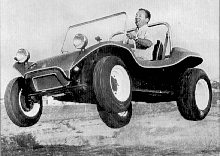
Bruce grew up in California during the early days of surfing, drag racing, and hanging out at the beach. Bruce served his country during W.W.II and managed to get an aircraft carrier shot out from underneath him. After the war he sailed to the South seas and built a trading post in the Cook Islands. It was his love of sailing that got him interested in building boats.
Bruce designed and built many small catamarans, among them a 42 foot catamaran that proved to be a winner. Bruce then went on to build the tooling for even more fiberglass sailboats including the California Series designed by Bill Lapworth.
It was on Pismo Beach that he first became acquainted with "Dune Buggies". These were V8 powered "water pumpers". These machines were crude and heavy so Bruce took it upon himself to design a lightweight version that would be fun on the beach or in the wilds of Baja. After modifying a Kombi bus with wide rims (called "Little Red Riding Bus") Bruce used his expertise in boat building to design the first fiberglass bodied dune buggy.
The first 12 cars produced were monocoque bodies that had their own integral frame with VW engine and transmission (Bruce has restored and now drives old #4). These cars were expensive and difficult to produce so Bruce re- designed the body to fit on a VW shortened floorpan . As a result, the Meyers Manx started the off-road revolution by building 5,280 Manx kits and several hundred Manx II's - a total of nearly 6,000 Manx kits.
The Meyers Manx took the country by storm when magazines like Hot Rod featured the fiberglass car on their covers (it was the first picture of car jumping into the air just for the fun of it !). The Meyers Manx was so popular that other manufacturers sprung up overnight and ended up producing over 250,000 look-a-likes and near look-a-likes. Bruce tried to stop the floodgates of copies with patent infringement laws but failed to convince the courts that he had produced anything worth a patent.
The performance of the Meyers Manx was amazing ! It handled better than any other off-road vehicle and was much more fun to drive. The Manx won numerous slalom events and the Pike's Peak Hill Climb(beating Corvettes, Cobras, and most open wheel sprint cars). It set the record for traveling the length of Baja at 34 hours and 45 minutes (driven by Bruce and Ted Mangels who beat the motorcycle record by more than five hours).
The Meyers company went on to produce the Tow'd for off-road use only. It was an attempt to short circuit the Manx copy cats but had production problems and never really caught on (about 850 kits sold). The body was smaller and lighter then the Manx built on a custom frame. Bruce raced the Tow'd in the second Baja 1000 and ended by crashing and breaking both legs.
The next product of the company was the Meyers Manx S.R. (Street Roadster). This car was designed for the street only and possessed a sleek aerodynamic shape. It was built to fit on the same shortened VW floorpan as the original Manx to keep the great handing characteristics. The car had thirteen fiberglass and many metal pieces . There were 400 to 600 of these kits sold.
The Resorter/Turista was also produced by the company to provide a 4 seat version of the Manx. The Resorter had lower sides for easier entrance and exit. The car was originally produced for hotel chains to carry tourists. Bruce was not fond of the shape and claimed the sight of it gave him the "touristas" ("Montezuma Revenge").
A few Utility cars were produced that included vehicles for the Lifeguards of Los Angeles County and the rangers of the Forest Service. The cars were equipped with flat rear bed for hauling gear which required the use of a VW "pancake" engine.
The last vehicle in the Manx fleet is the Kublewagon . This car is designed to be a replica of the German Desert Staff car of WWII and is built on a full length floorpan. This car was featured in an issue for Hot VW's last year. Sadly, there was only one of these cars built. The total number of kits of all types and completed cars was about 7,000.
The Meyers Manx company went out of business in 1971 due to the strains of fighting the cheap imitations of the copiers , the loss of the patent infringement case, and the tax demands of the I.R.S.